Summer rules indeed! The golfing standard flying above the Piping Rock Club in Locust Valley on a brilliant summer day.
How many small towns in the world boast multiple world-class golf courses? Not many. Southampton, New York, home to Shinnecock Hills and the National Golf Links of America springs to mind, as does Pebble Beach, California. Locust Valley, New York, also packs two exceptional golf courses into a town that measures less than a square mile.
Locust Valley
Locust Valley, New York, located on the North Shore of Long Island, thirty minutes from Times Square, is a place of privilege: its rolling hills are dotted with country houses and baronial mansions redolent of an earlier era; one dominated by Robber barons and names like Morgan and Vanderbilt; a place visited by F.D.R. and the Duke and Duchess of Windsor; a leafy enclave that conjures up memories of a bygone grandeur; an outpost of old money. Locust Valley also sports two Charles Blair Macdonald designed golf courses: the Piping Rock Club, built in 1911, and The Creek, built during the Roaring Twenties.
Between the last decade of the nineteenth century and 1930 over 1,200 mansions were built on the North Shore of Long Island, which became known as the "Gold Coast." They were the types of "cottages" that were tended to by gardeners, maids, and cooks, where the owners lost track of how many rooms there were. Proper etiquette here was (and still is) to hide your wealth, so many of the homes are set back and cannot be seen from the street. Although unseen, the architecture and grounds of the stately homes were often times staggering. Where I grew up in Jersey the houses didn't have reception halls, rose gardens, rotunda, and porte cochère. On the Gold Coast they were de rigueur.
The lifestyles of the rich and famous of this era prominently featured Locust Valley. Imagine yourself a captain of industry, a titan of Wall Street, or a super lawyer. You dominate the world during the day, hang at your exclusive private city clubs (the Brook, Links, Knickerbocker, Union) at night and visit your country houses and mansions in Locust Valley and Southampton on the weekends. It was the type of place where young ladies made their debut as a debutante; where the "horse set" could pursue their passions; where women hosted luncheons and garden parties during the day; a place dominated by men with roman numerals after their names. Although not as widely thought of today as Newport, Bar Harbor, or Martha's Vineyard, the little village was a prominent stomping ground for the elite as America rose to prominence in the world. Locust Valley is a place Jay Gatsby would be familiar with.
The lifestyles of the rich and famous of this era prominently featured Locust Valley. Imagine yourself a captain of industry, a titan of Wall Street, or a super lawyer. You dominate the world during the day, hang at your exclusive private city clubs (the Brook, Links, Knickerbocker, Union) at night and visit your country houses and mansions in Locust Valley and Southampton on the weekends. It was the type of place where young ladies made their debut as a debutante; where the "horse set" could pursue their passions; where women hosted luncheons and garden parties during the day; a place dominated by men with roman numerals after their names. Although not as widely thought of today as Newport, Bar Harbor, or Martha's Vineyard, the little village was a prominent stomping ground for the elite as America rose to prominence in the world. Locust Valley is a place Jay Gatsby would be familiar with.
The Piping Rock Club
Piping Rock's original membership rolls were a who's who of the pre-war establishment including J. P. Morgan, Jr., Louis C. Tiffany, Conde Nast, Averell Harriman, Percy Chubb, John S. Phipps, William Vincent Astor, Cornelius Vanderbilt, and Frank N. Doubleday. President Theodore Roosevelt was an honorary member. In addition to being the course designer, Charles Blair Macdonald was also a member and chairman of the golf committee.
Piping Rock was established in the model of a classic club of its era, organized to allow its members to enjoy country pursuits. The club was named based on a legend that Native Indians used a large rock on the property as a location to smoke the "pipe of peace," thus, the piping rock. The Brooklyn Daily Eagle, writing in 1909, described the fact that the property the club secured was done so, "because of its absolute perfection of country sports," and noted that it was set in "the land of princely estates," and was ideal for, "providing on a large and elaborate scale for out-of-door sports with polo, pony racing, tennis, and possibly golf, and in any event cross country riding well to the fore. " As noted, the club's focus was not golf; they also established a steeplechase course which included a grandstand for spectators.
Piping Rock was established in the model of a classic club of its era, organized to allow its members to enjoy country pursuits. The club was named based on a legend that Native Indians used a large rock on the property as a location to smoke the "pipe of peace," thus, the piping rock. The Brooklyn Daily Eagle, writing in 1909, described the fact that the property the club secured was done so, "because of its absolute perfection of country sports," and noted that it was set in "the land of princely estates," and was ideal for, "providing on a large and elaborate scale for out-of-door sports with polo, pony racing, tennis, and possibly golf, and in any event cross country riding well to the fore. " As noted, the club's focus was not golf; they also established a steeplechase course which included a grandstand for spectators.
Piping Rock today retains the air of its founding days. Driving up to the Dutch Colonial clubhouse flanked by a stone wall gives the visitor a sense of being a country gentleman or lady. The entire scene is one of a leisurely enclave. Nearby the clubhouse are beautifully maintained grass tennis courts. Like the C.B. Macdonald-designed St. Louis Country Club, the visitor at Piping Rock is also drawn immediately to the prominence of the old polo field behind the clubhouse.
The closing par five "Home" hole at Piping Rock
Surrounding the tennis courts, clubhouse, and polo fields is the rolling terrain of the golf course. As courses designed by C. B. Macdonald and built by Seth Raynor do, both Piping Rock and The Creek follow their usual "prototype" hole patterns. Piping Rock includes renditions of a Long, Road, Biarritz, Redan, Eden, Knoll, Short, and Home holes.
Piping Rock is a fun course to play and has an interesting and varied routing. It is beautifully conditioned and offers challenging greens. Piping Rock is the longer of the two layouts, at 6,800 yards from the tips. The Creek maxes out at 6,450, although, given the steeper terrain at The Creek, yardages can be deceiving.
The classic "Biarritz" style green on the par three 9th hole at Piping Rock
The front nine at Piping Rock plays on the property's more open terrain, the back through a more wooded area. Darius Oliver mentions in Planet Golf USA that Piping Rock represents a significant course in architectural history because it was the first inland course Macdonald and Raynor built, immediately after the completion of the National Golf Links. Although he routed the course, Macdonald became irritated with the land he was given by the club and left most of the course's design and construction to Raynor.
A full view of the Biarritz green, a fabulous rendition of this challenging hole
Tom Doak was a consulting architect at Piping Rock, describing the property as "open parkland on terrain reminiscent of Chicago Golf Club." His course revisions we're all accepted, and he takes a shot at the club in his book, describing those who voted to remove a hazard he put in on the tenth hole as "dunces." Although he gives Piping Rock a '6' rating on his scale of 0-10, he gives The Creek a '7' but a lot more love.
A view from the sixth hole looking back across the old polo field (now the driving range) to the clubhouse at Piping Rock
When the club commissioned Guy Lowell to design the clubhouse their mandate was to build, "the sort of thing that George Washington would have built if he had the money." He didn't disappoint.
The Creek
The Creek's founding members (limited to 100 men) included Vincent Astor, Marshall Field, J. P. Morgan, Frank Crocker, H. L. Pratt (the president of Standard Oil), Charles B. Mackay (whose father discovered the Comstock Lode mine) and Harry Payne Whitney. When it opened, the New York Times called it the "Millionaire Golf Club."
The Brooklyn Daily Eagle described The Creek in 1923, shortly after its opening: "Recognized as one of the most exclusive country clubs in America, it commands one of the most magnificent views of Long Island Sound, the golf course sweeping away to the Sound shore, where even one of the holes is located on an island." The antithesis of another great course located on Long Island, Bethpage Black, there was no waiting in line and no crowds for the members at The Creek. The club and its privileged members took advantage of the location. As noted by the Eagle, "The property includes a shore casino and private yacht landing, where the big steam yachts dock in the summer, discharging their owners, who can tee off from the island hole and proceed around the course without ever touching a highway."
Occupying one the highest pieces of land on Long Island, The Creek occupies a special 130 acres that were formerly the estate of Paul D. Cravath, a partner at the white-shoe law firm (at the time, the largest law firm in the world) that today exists as Cravath, Swaine & Moore. Similar to arriving at the National Golf Links and at Sebonack, both further east on Long Island, the arrival at The Creek is grand. You drive through a set of old brick gates guarding the entrance and through an impressive allée of linden trees. At the far end of the road you turn into a circular entry drive. The first building in the circle is the old Cravath estate horse stable, which has been converted into the locker room and pro shop. At the far end of the circle is the handsome classic clubhouse, built of Indiana limestone in the Georgian Greek Renaissance style.
The impressive entry gate to The Creek with its long allée of trees
The expansive view of The Creek property from the clubhouse veranda, 18th green in foreground, the par 3 seventeenth in the middle distance surrounded by sand
The golf course itself is a tale of three cities. Holes one through five occupy the flat, higher elevation part of the property and are the least interesting. Holes seven through fourteen occupy the flat beach/links part of the property, while holes six through eight and fifteen through eighteen are on a broad hill. Each of the three parts has a distinctive feel.
During The Creek's construction Seth Raynor was assisted by "Carnoustie man" Alex Balfour.
The punchbowl green on the 6th, my favorite hole
The course takes its name from a tidal creek that flows through the lower part of the property, a broad view of which is seen in the picture below.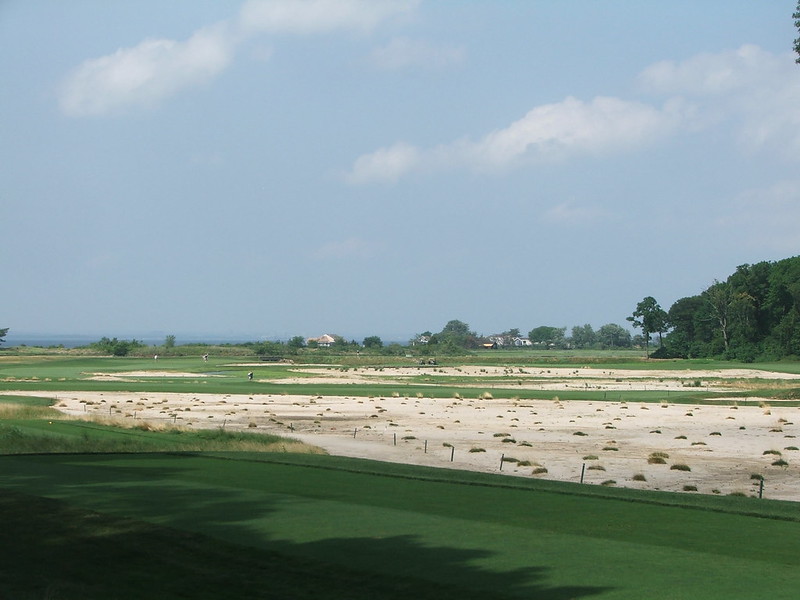
The lower linksy part of The Creek showing the sandy terrain
This lower portion of the course is closer to Long Island Sound and is thus more impacted by the winds.
The par four tenth hole, a "Cape" that plays near Long Island Sound
A nice rendition of a Cape hole, the par four tenth asks the golfer how much risk they are willing to take on with a chance to be closer to the green if successful. Although the hole's name is "Cape," a article in the New York Times during the course's construction in 1922 notes that the hole was patterned as a "Leven" hole, specifically after the 17th hole at the National Golf Links, which seems a bit odd given that on the surface it doesn't share many characteristics.
The "Island" 11th green at The Creek
The par three eleventh hole is a stern test of golf, particularly if the wind is blowing. Its 200-yards demand a precise tee shot to hit the island green that the golfer reaches and departs from via wooden bridges. Making it even more of a challenge, the memorable hole features an 80-yard long Biarritz-style green with a large swale running through it.
The beach clubhouse at The Creek, located behind the 10th tee is an integral part of the experience
I like both Piping Rock and The Creek and don't have a strong preference for one over the other. I don't know if there are people that don't like C. B. Macdonald-designed courses, but I'm not one of them. Both are fine places to play.
Playing at these clubs is much more than simply a round of golf, it is a brief and educational immersion experience into the mores, traditions, and rituals of how the most fortunate among us lives. In the Northeastern U.S. we might not have the year round perfect weather that California does, nor the ability to play during the winter like those in the South do, but it is tough to beat a round near the shoreline in New York during July and August at an old-school bastion of golf. Along with Maidstone and Fishers Island, teeing it up on a fine summer day at either The Creek or Piping Rock is one of the game's great pleasures and gives you a sense of how the other half lives.
Playing at these clubs is much more than simply a round of golf, it is a brief and educational immersion experience into the mores, traditions, and rituals of how the most fortunate among us lives. In the Northeastern U.S. we might not have the year round perfect weather that California does, nor the ability to play during the winter like those in the South do, but it is tough to beat a round near the shoreline in New York during July and August at an old-school bastion of golf. Along with Maidstone and Fishers Island, teeing it up on a fine summer day at either The Creek or Piping Rock is one of the game's great pleasures and gives you a sense of how the other half lives.
An image of Paul Cravath's original "Country House" estate in Locust Valley gives a good sense of the opulence of the era and the area
Although members might not drive their "power yachts" up to the beach club as frequently as they did back in the Jazz Age, the town of Locust Valley remains a bastion of privileged affluence.
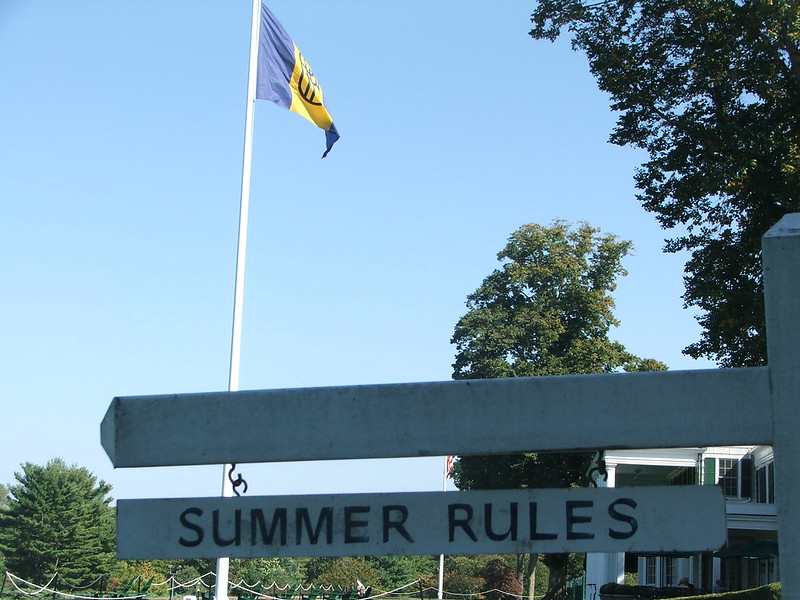
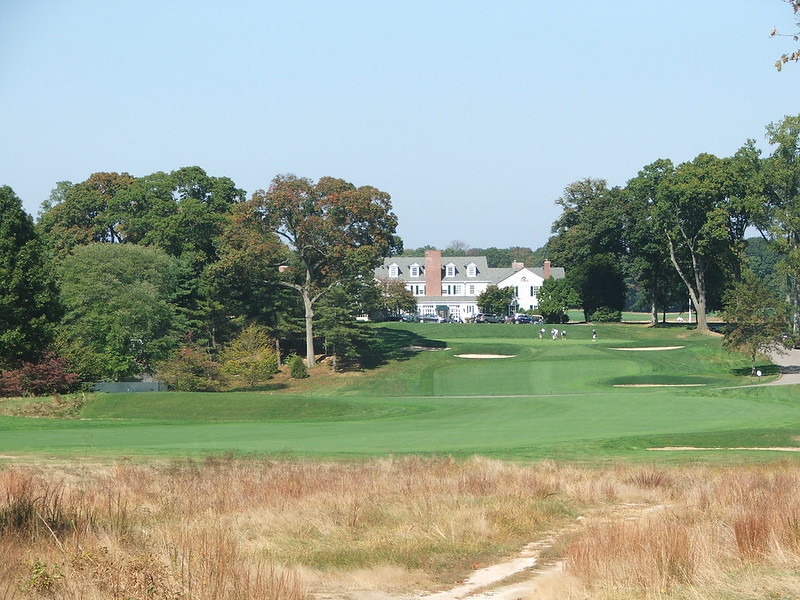

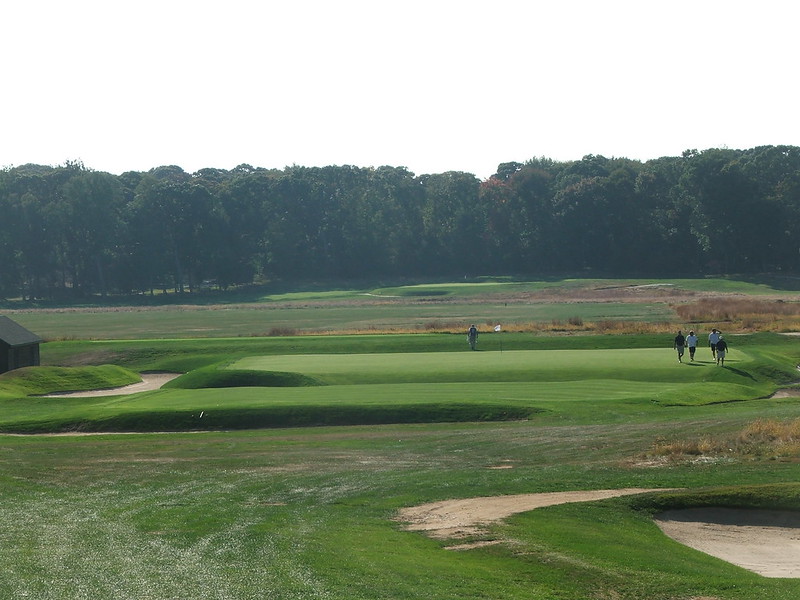
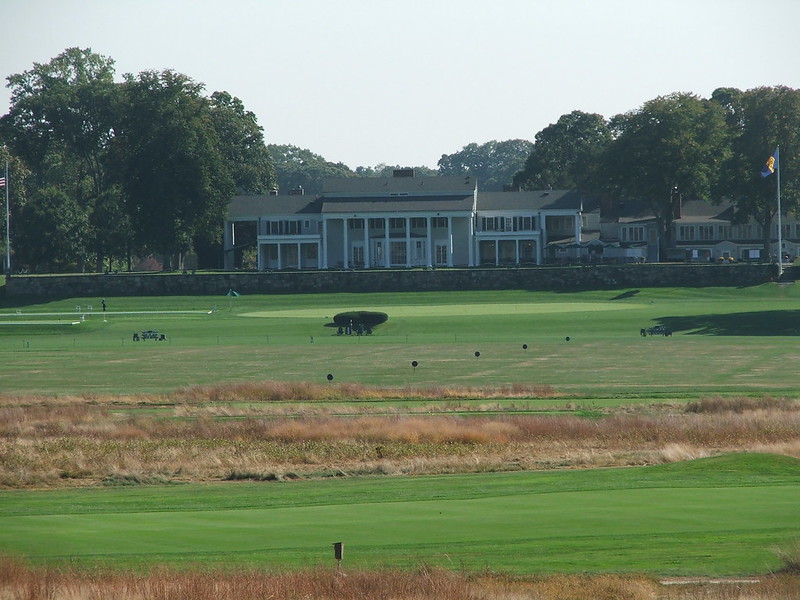
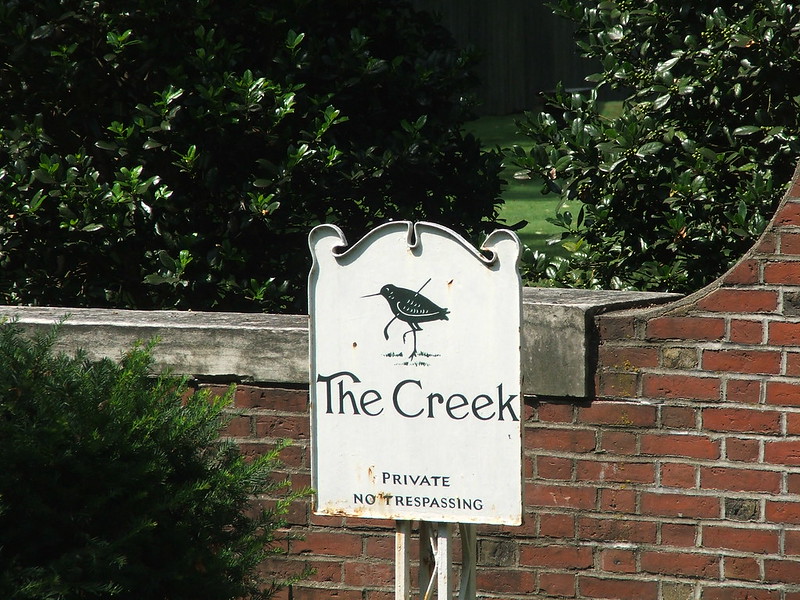
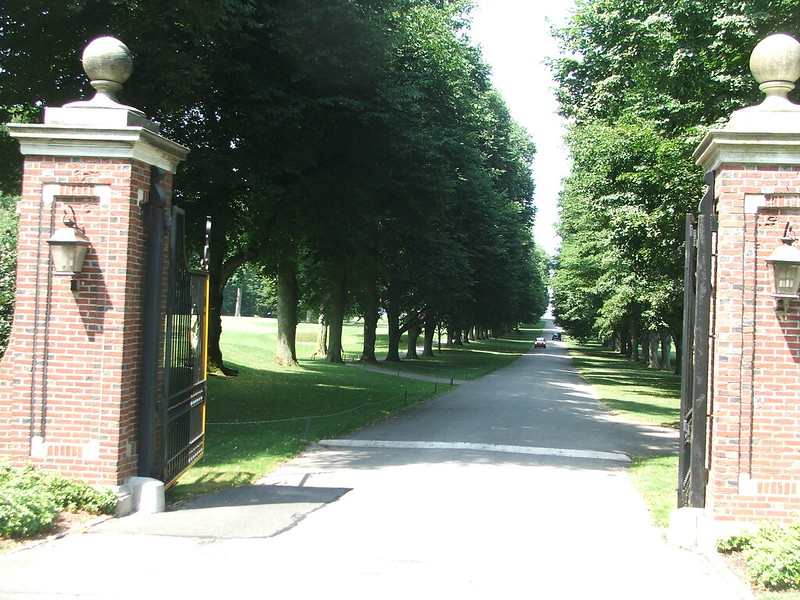
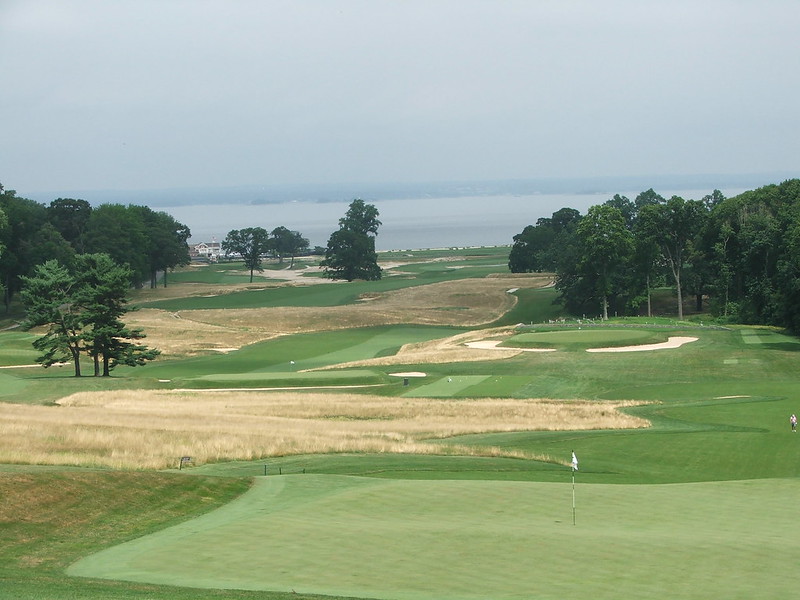
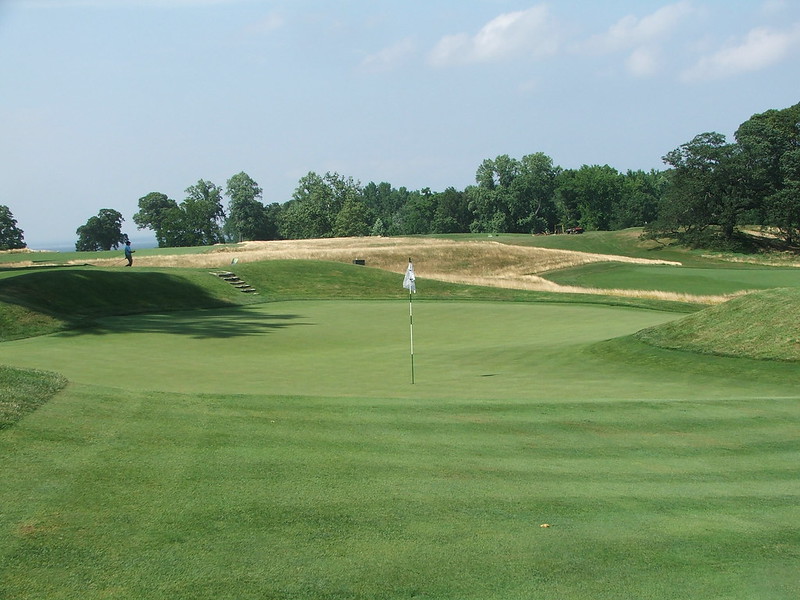
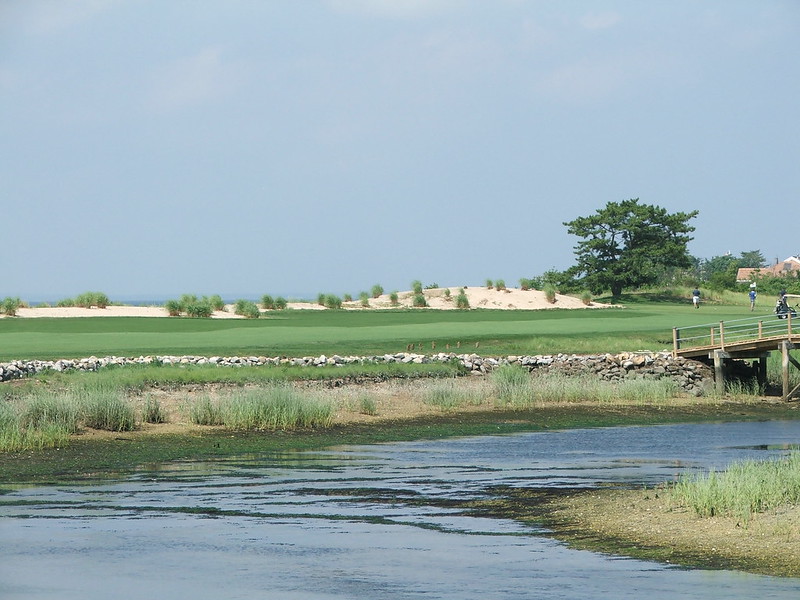
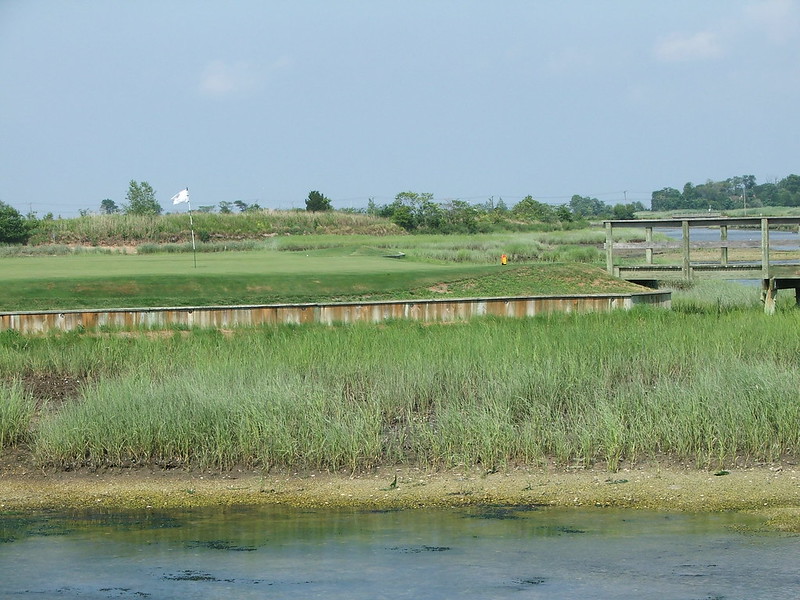
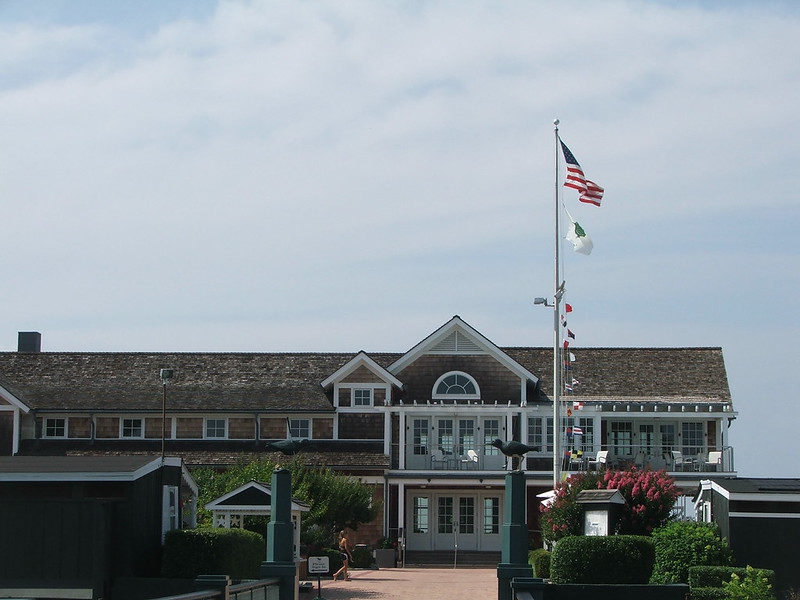





No comments:
Post a Comment